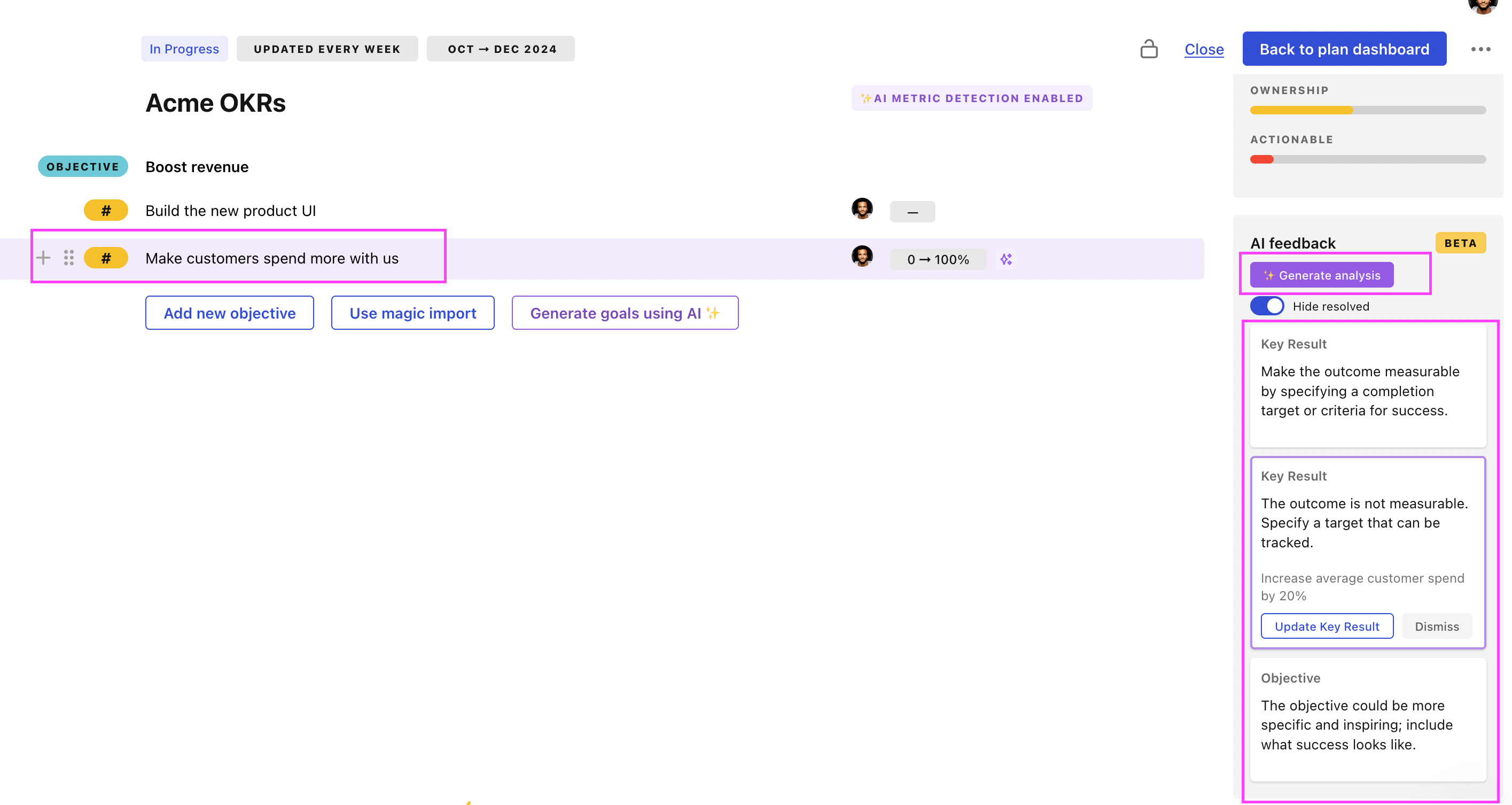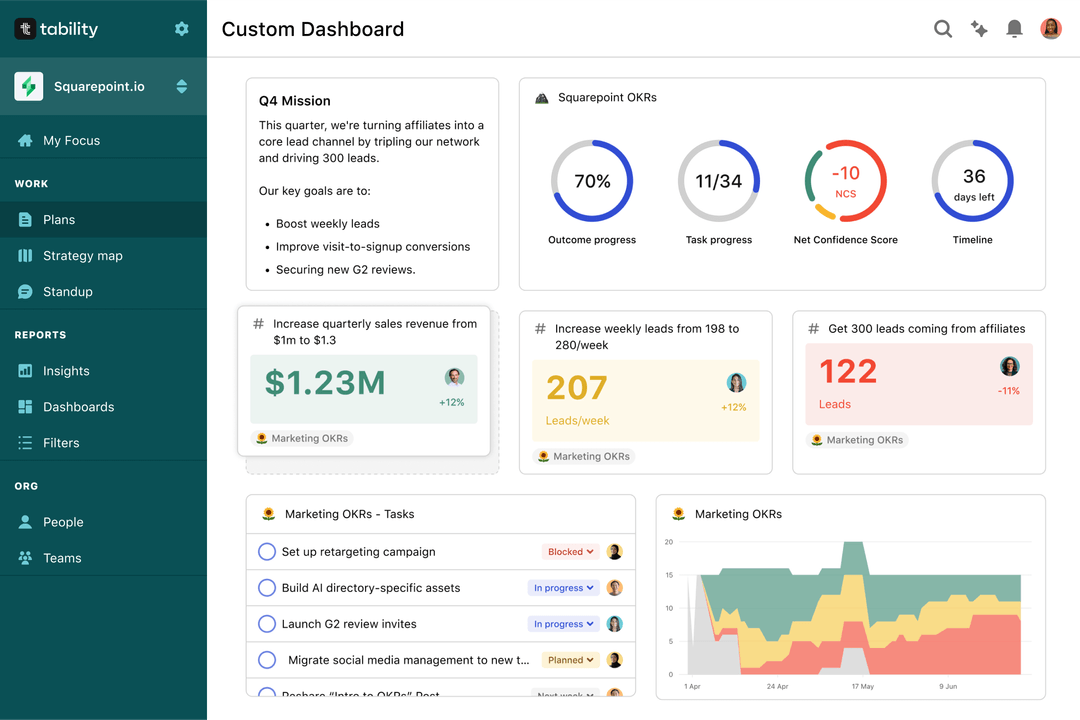Tability is a cheatcode for goal-driven teams. Set perfect OKRs with AI, stay focused on the work that matters.
What are Intervention Team OKRs?
The OKR acronym stands for Objectives and Key Results. It's a goal-setting framework that was introduced at Intel by Andy Grove in the 70s, and it became popular after John Doerr introduced it to Google in the 90s. OKRs helps teams has a shared language to set ambitious goals and track progress towards them.
Formulating strong OKRs can be a complex endeavor, particularly for first-timers. Prioritizing outcomes over projects is crucial when developing your plans.
We've tailored a list of OKRs examples for Intervention Team to help you. You can look at any of the templates below to get some inspiration for your own goals.
If you want to learn more about the framework, you can read our OKR guide online.
The best tools for writing perfect Intervention Team OKRs
Here are 2 tools that can help you draft your OKRs in no time.
Tability AI: to generate OKRs based on a prompt
Tability AI allows you to describe your goals in a prompt, and generate a fully editable OKR template in seconds.
- 1. Create a Tability account
- 2. Click on the Generate goals using AI
- 3. Describe your goals in a prompt
- 4. Get your fully editable OKR template
- 5. Publish to start tracking progress and get automated OKR dashboards
Watch the video below to see it in action 👇
Tability Feedback: to improve existing OKRs
You can use Tability's AI feedback to improve your OKRs if you already have existing goals.
- 1. Create your Tability account
- 2. Add your existing OKRs (you can import them from a spreadsheet)
- 3. Click on Generate analysis
- 4. Review the suggestions and decide to accept or dismiss them
- 5. Publish to start tracking progress and get automated OKR dashboards

Tability will scan your OKRs and offer different suggestions to improve them. This can range from a small rewrite of a statement to make it clearer to a complete rewrite of the entire OKR.
Intervention Team OKRs examples
You'll find below a list of Objectives and Key Results templates for Intervention Team. We also included strategic projects for each template to make it easier to understand the difference between key results and projects.
Hope you'll find this helpful!
OKRs to improve IT Tech retail store deployment through automation enhancements
ObjectiveImprove IT Tech retail store deployment through automation enhancements
KRIncrease automation efficiency by 25% via software upgrades and tools integration
Implement chosen software upgrades and integrate tools
Research and select appropriate software upgrades
Identify areas of workflow that need automation improvement
KRTrain 90% of project team on new automation tools to boost deployment speed
Identify qualified trainers to teach the new automation tools
Monitor and evaluate team members' mastery of the new tools
Schedule training sessions for all project team members
KRReduce manual intervention in deployments by 30% by automating repetitive tasks
Research and implement automation tools
Train staff in using these automation tools
Identify repetitive tasks during deployments
OKRs to secure three drilling and two well intervention contracts
ObjectiveSecure three drilling and two well intervention contracts
KRSubmit 5 well structured proposals for well intervention contracts
KRIdentify and establish contact with 10 potential clients for drilling contracts
Research companies in need of drilling contracts
Reach out to each client with a customized proposal
Compile a list of 10 potential clients
KRSuccessfully close negotiations with at least 2 clients each for drilling and interventions
Prepare comprehensive, customized proposals for each client
Engage clients in constructive negotiation meetings
Finalize contracts and obtain client signature
OKRs to enhance impact of capacity-strengthening interventions
ObjectiveEnhance impact of capacity-strengthening interventions
KRSecure positive feedback from 85% of beneficiaries on intervention effectiveness
KRAchieve a 20% improvement in participants' post-intervention skills assessment scores
KRIncrease participant enrolment by 30% in capacity-building programs
Develop a compelling marketing campaign highlighting program benefits
Implement a lucrative referral incentive system for current participants
Collaborate with community influencers for endorsement and promotion
OKRs to enhance teaching efficiency for effective learning outcomes
ObjectiveEnhance teaching efficiency for effective learning outcomes
KRIncrease student attendance in intervention sessions by 30% to improve overall grades
Publicize success stories to highlight session benefits
Reward consistent attendance to motivate further participation
Develop engaging content to make intervention sessions interesting
KRImplement a new teaching methodology that increases student engagement by 20%
Monitor and evaluate student engagement rates
Train teachers in the new teaching methodology
Create engaging, interactive lesson plans
KRReduce average feedback response time by 50% to increase student understanding
Train staff on efficient feedback methods
Allocate additional resources to feedback processes
Implement a streamlined online feedback system
OKRs to implement strategies for improved success with behaviorally challenged children
ObjectiveImplement strategies for improved success with behaviorally challenged children
KRDevelop a comprehensive behavior management strategy by collaborating with two child psychologists
Discuss and outline behavior management strategy
Review and refine strategy draft with psychologists
Schedule meeting to collaborate with two child psychologists
KRConduct weekly sessions teaching staff new behavior management strategies resulting in 80% staff proficiency
Curate relevant and practical strategies for each session
Implement proficiency assessments post training
Schedule regular weekly sessions for behavior management training
KRRecord a 25% reduction in incidents of challenging behaviors through new intervention techniques
Identify current incidents and classify challenging behaviors
Monitor and assess reduction in challenging behaviors
Develop and implement new intervention techniques
OKRs to boost average adherence and attendance to 98%
ObjectiveBoost average adherence and attendance to 98%
KRInstigate no less than 2 motivational interventions to maintain 98% rates
Monitor and adjust tactics to maintain 98% rates
Identify two potential motivational interventions to implement
Execute the identified motivational interventions promptly
KRAchieve a 98% attendance rate by improving online forum engagement
Offer incentives for consistent forum activity
Create weekly engaging forum discussions
Implement a leaderboard to encourage active forum participation
KRIncrease weekly adherence percentage to 98% within first month
Implement incentives for high compliance
Conduct weekly checks to monitor adherence
Develop a clear, easy-to-follow protocol
OKRs to enhance nonprofits' performance through capacity-strengthening interventions
ObjectiveEnhance nonprofits' performance through capacity-strengthening interventions
KRAchieve a minimum of 20% increase in capacity utilization across all nonprofits
Deliver capacity-building training for nonprofit staff
Implement efficiency-boosting technology across all operations
Optimize resource allocation via data analysis
KRObtain positive feedback on interventions from at least 80% of nonprofits' management
Analyze and implement feedback changes
Create and distribute survey on intervention effectiveness to nonprofits' management
Conduct follow-up interviews for detailed responses
KRImplement capacity-strengthening interventions to enhance operational efficiency in all 10 nonprofits
Define specific capacity-strengthening measures required for each area
Identify key areas for operational enhancement across all nonprofits
Execute and monitor the implementation process of said interventions
Intervention Team OKR best practices
Generally speaking, your objectives should be ambitious yet achievable, and your key results should be measurable and time-bound (using the SMART framework can be helpful). It is also recommended to list strategic initiatives under your key results, as it'll help you avoid the common mistake of listing projects in your KRs.
Here are a couple of best practices extracted from our OKR implementation guide 👇
Tip #1: Limit the number of key results
Having too many OKRs is the #1 mistake that teams make when adopting the framework. The problem with tracking too many competing goals is that it will be hard for your team to know what really matters.
We recommend having 3-4 objectives, and 3-4 key results per objective. A platform like Tability can run audits on your data to help you identify the plans that have too many goals.
Tip #2: Commit to weekly OKR check-ins
Setting good goals can be challenging, but without regular check-ins, your team will struggle to make progress. We recommend that you track your OKRs weekly to get the full benefits from the framework.
Being able to see trends for your key results will also keep yourself honest.
Tip #3: No more than 2 yellow statuses in a row
Yes, this is another tip for goal-tracking instead of goal-setting (but you'll get plenty of OKR examples above). But, once you have your goals defined, it will be your ability to keep the right sense of urgency that will make the difference.
As a rule of thumb, it's best to avoid having more than 2 yellow/at risk statuses in a row.
Make a call on the 3rd update. You should be either back on track, or off track. This sounds harsh but it's the best way to signal risks early enough to fix things.
Save hours with automated Intervention Team OKR dashboards

OKRs without regular progress updates are just KPIs. You'll need to update progress on your OKRs every week to get the full benefits from the framework. Reviewing progress periodically has several advantages:
- It brings the goals back to the top of the mind
- It will highlight poorly set OKRs
- It will surface execution risks
- It improves transparency and accountability
Spreadsheets are enough to get started. Then, once you need to scale you can use Tability to save time with automated OKR dashboards, data connectors, and actionable insights.
How to get Tability dashboards:
- 1. Create a Tability account
- 2. Use the importers to add your OKRs (works with any spreadsheet or doc)
- 3. Publish your OKR plan
That's it! Tability will instantly get access to 10+ dashboards to monitor progress, visualise trends, and identify risks early.
More Intervention Team OKR templates
We have more templates to help you draft your team goals and OKRs.
OKRs to minimize technical debt across all 100 crawlers
OKRs to reduce staff turnover across the company
OKRs to elevate recycling and waste collection performance
OKRs to expand audience reach
OKRs to regain 35% of lost customers from our database
OKRs to enhance product discovery for improved client engagement